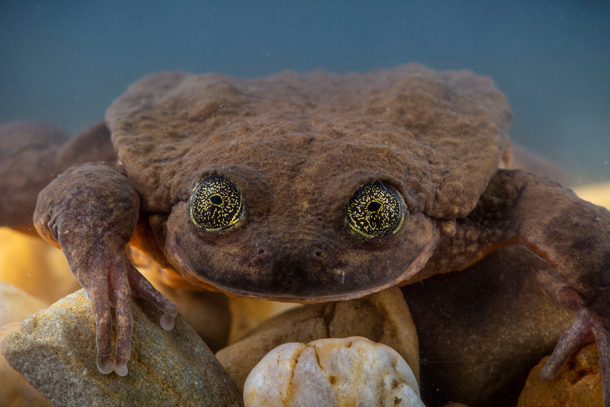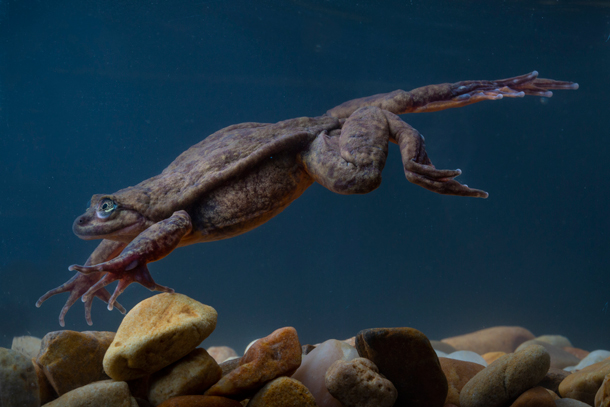Note on Emerging Science: Matchmaking for a Frog Named "Romeo"
Air Date: Week of March 8, 2019

Scientists hope that the surviving Sehuencas frogs have developed genetic resistance to the chytrid fungus. (Photo: Juliet by Robin Moore, Global Wildlife Conservation)
Sehuencas water frogs, like other amphibians, have been devastated by the chytrid fungus, and a frog that scientists named “Romeo” was the last known frog of his kind until scientists discovered a couple of potential mates for Romeo hiding in the Bolivian mountains. As Living on Earth’s Don Lyman reports with this note on emerging science, they hope that these frogs may be immune to the deadly chytrid fungus.
Transcript
CURWOOD: Just ahead, cloning ancient redwood trees that appear to be dead but first this note on emerging science from Don Lyman.
[SCIENCE NOTE THEME]
LYMAN: A group of scientists from the University of Maryland recently announced the discovery of a Bolivian frog species that was believed to be extinct in the wild. Although one Sehuencas water frog, named Romeo, survived in captivity, the species hadn't been seen in the wild for 10 years. Scientists blamed chytridiomycosis, a fungal disease that has wiped out frog populations around the world. But researchers found five of the frogs in a cloud forest in the Bolivian mountains. They speculate that the five surviving frogs may have immunity or genetic resistance to the deadly fungus.

Juliet, the Sehuencas frog (Photo: Robin Moore, Global Wildlife Conservation)
The frogs' survival could also be due to an environmental factor, like an unusually warm microclimate that was not conducive to the growth of the fungus. There's currently no way to eradicate the chytrid fungus in the wild, so scientists are eager to study the surviving frogs and to try to breed them as part of a captive conservation breeding program, possibly resulting in Sehuencas frogs that are resistant to the deadly fungus. The discovery gives researchers hope that more Sehuencas water frogs might be found in the wild. It also gives scientists a chance to help the species recover, and to introduce Romeo to one of the female frogs, who they've appropriately named Juliet. That's this week's note on emerging science. I'm Don Lyman.
Links
Lonely No More: Romeo the Sehuencas Water Frog Finds Love
Science News | This Rediscovered Bolivian Frog Species Survived Deadly Chytrid Fungus
Living on Earth wants to hear from you!
Living on Earth
62 Calef Highway, Suite 212
Lee, NH 03861
Telephone: 617-287-4121
E-mail: comments@loe.org
Newsletter [Click here]
Donate to Living on Earth!
Living on Earth is an independent media program and relies entirely on contributions from listeners and institutions supporting public service. Please donate now to preserve an independent environmental voice.
NewsletterLiving on Earth offers a weekly delivery of the show's rundown to your mailbox. Sign up for our newsletter today!
 Sailors For The Sea: Be the change you want to sea.
Sailors For The Sea: Be the change you want to sea.
 The Grantham Foundation for the Protection of the Environment: Committed to protecting and improving the health of the global environment.
The Grantham Foundation for the Protection of the Environment: Committed to protecting and improving the health of the global environment.
 Contribute to Living on Earth and receive, as our gift to you, an archival print of one of Mark Seth Lender's extraordinary wildlife photographs. Follow the link to see Mark's current collection of photographs.
Contribute to Living on Earth and receive, as our gift to you, an archival print of one of Mark Seth Lender's extraordinary wildlife photographs. Follow the link to see Mark's current collection of photographs.
 Buy a signed copy of Mark Seth Lender's book Smeagull the Seagull & support Living on Earth
Buy a signed copy of Mark Seth Lender's book Smeagull the Seagull & support Living on Earth

